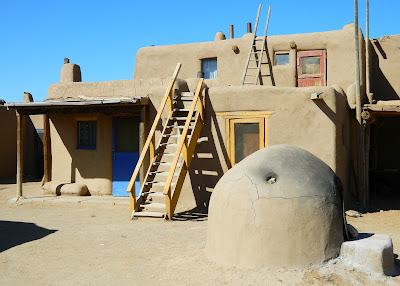A long time ago, when I was maybe 10 years old, my parents and I travelled to Taos, NM so my father could receive their recognition and thanks for doing some work for the Pueblo. They were in the midst of a struggle to maintain control and exclusive access to Blue Lake, a sacred place for their people. My father had supported their case, probably with an amicus brief and as an expert witness, in either the state or the federal courts, justifying the Pueblo's claim as a right to religious freedom. I don't remember all the details, but I do remember the unique feel of being there and the honor I felt on behalf of my father. We may have been there at a time when there were some ceremonial dances. The chief at the time gave my father a gift of a basket made at the pueblo, and I still have it hanging in our RV. So it was pretty special to be back there again. I do believe they may have won their case, at least in part, as the land around Blue Lake is now off limits to anyone but the tribe.
The Taos Pueblo is distinct from the town of Taos, which is a touristy, hectic kind of place, with traffic jams and not enough parking. The Pueblo is very quiet. It is recognized as the longest continuously inhabited community in the country, and the present buildings (excluding the church) are estimated at 1000 years old.
The buildings are all made of adobe, a mixture of earth and straw. The adobe is refurbished every year.
The pueblo is comprised of two major residential structures with a few smaller ones clustered nearby, two ceremonial areas with several kivas each, the mission church, a few corrals, and a cemetery. There is a stream running through the middle, which is their only water source. There is no electricity or plumbing in the buildings. The residential structures have many family homes, like apartments, that are all separate but with shared walls, and originally the only entrance to each home was through the roof. Doors were added in more recent times and are often brightly painted in contrast to the monochromatic adobe. The round structure in the photo below is an oven where bread is baked.
The original San Geronimo (St. Jerome) church was built by Catholic missionaries in 1619 then destroyed twice in revolts or altercations (and interesting history worth reading about) and rebuilt in its current location in 1850. That pole you can see through the gate below is not a telephone pole, it is a ceremonial pole for some ritual purpose. I don't think I saw any telephone poles.
The San Geronimo church is quite beautiful inside, with artistic references to both Catholic figures and Native American culture. (No photography allowed.)
The original church, in ruins, is now a cemetery.
The Tiwa people who built and reside in the pueblo practice a blend of Catholicism and their traditional beliefs. Almost all their names are Spanish as a result of the missionary influences over the centuries. Along with the church and the Catholic cemetery there are traditional kivas in the Pueblo - round, below ground-level ceremonial structures, that are off limits to visitors (below). The Tiwa keep their sacred beliefs and rituals very private.
Ristras, or strings of dried chilies hang from the supporting beams throughout the Pueblo.
Ladders are still used to access the different levels of the Pueblo buildings.
The road back to Chama crossed over the Rio Grande Gorge. I had no idea there even was a Rio Grande Gorge, so this was a complete surprise. And it is really grande - 650 deep at the point where the Rt. 64 bridge crosses it. Looking down, those of us on the bridge watched five big horn sheep traverse the sides of the gorge, eating as they went.
And another surprise! The Earthship Community! The visitor's center is right on Rt. 64, west of Taos and the residential community is spread among the hills adjacent to the visitor's center.
There seems to be a lot of building going on, but not on Sunday when I was passing by.
The sign says, "Warning! Official U.S.A. Sustainable Testing Site, 2.00 Acres" ???? I don't even know if it was serious or a joke. It could be a spoof on warning signs put up by the government around bombing sites. Is the government funding this experiment? I guess it wouldn't surprise me if they had grants from the feds - sounds like something Obama would support.
"The Earthship" is actually the name of this kind of home, designed to be energy efficient in multiple ways. Their website is full of information about it. Turns out they are in other locations as well. Looks like another planet doesn't it. Star Wars? These two homes are for sale.
So I had plenty to ponder about the comparison between the Earthships and the Taos Pueblo: innovative, alternative, high tech vs. traditional, alternative, low tech energy efficient communities. How has the traditional influenced the contemporary? Is there a future for either?
Refrain: Everything old is new again.















No comments:
Post a Comment
Want to leave a comment?